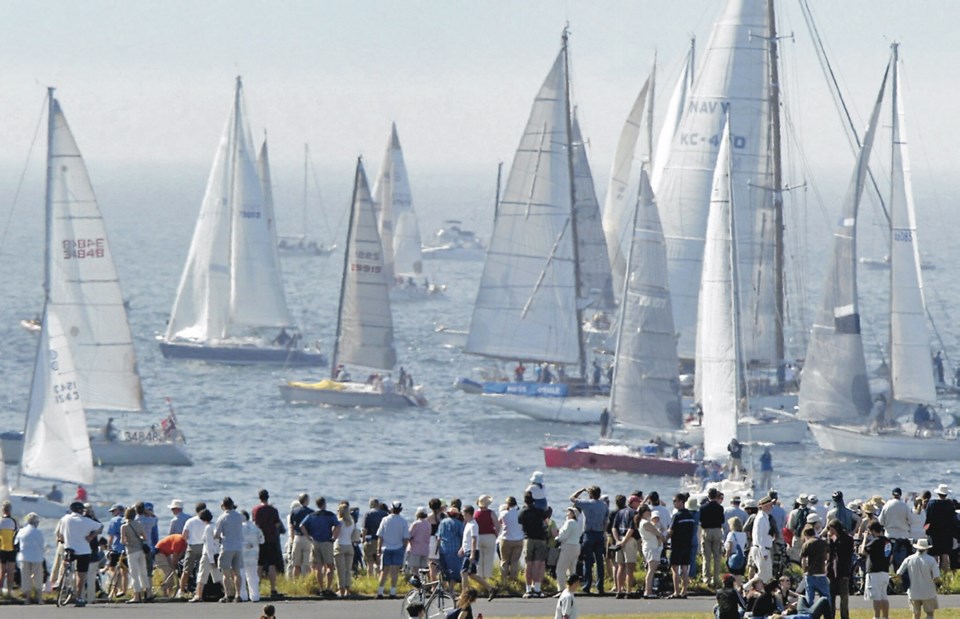One boat in Swiftsure Lightship Classic 2018 will sail with a crew dealing with personal handicaps but blessed with that unique team ethos that comes with military training.
STV (Sail Training Vessel) Goldcrest will race with an eight-person crew only the Canadian Armed Forces could put together. Four will be navy sailors and four will be military members dealing with service-related injuries — physical, psychological or emotional.
“We have all levels of disabled sailors,” said Lt.-Cmdr. Chris Maier, commander of the Canadian Naval Fleet School Pacific. “They can be serving members or veterans that we are trying to help return to full service or function.”
Maier, who is also commodore of the Canadian Forces Sailing Association, said Goldcrest is a 36-foot sailboat, one of two on the Pacific coast. They are used to train all Canadian Navy ranks and trades in the ways of rope work, wind and wave, the sorts of things that can only be learned close to the water.
He said when the idea was raised to use Goldcrest to assist recovering members and enter Swiftsure, he was eager to skipper. Military training, after all, provides people with a unique skill set — the ability to solve problems as part of a team. It can be deployed to overcome disabilities and other struggles. It’s almost made for a sailboat crew.
“That small-team environment, working together to solve problems or react to events, it’s what we learn in the military, and a sailboat is a great place to continue with that,” said Maier. “It just shows sailing is a really great sport for life.”
This year’s Swiftsure International Yacht Race, the 75th, will feature at least 200 boats, including Goldcrest.
That 200 number is a long way off the historic high set in 1981, when 441 boats entered. But organizers consider it a comfortable rebound after the low of 2011, when only 152 boats entered.
It’s also good proof of the continued success of Swiftsure, the largest competitive yachting event on the west coast of North America. It’s a handicapped race to give all entrants a more equal competitive chance. It’s also now a qualifying event for the Vic Maui International, in which entrants race from Victoria to Hawaii in July.
The Swiftsure International Yacht Race was first held in 1930 and featured only six boats. Save for a few halts for world events, the Great Depression and the Second World War, the race has continued.
The first Swiftsure Lightship Classic was named for a lightship, a floating lighthouse once anchored by the U.S. Coast Guard at Swiftsure Bank to mark the entrance to Juan de Fuca Strait.
The lightship was a convenient marker for yachts to use as turn-around point. That light is especially important as the total distance, 256 kilometres, would see the sailboat racers out on the Pacific after dark. The lightship has long been retired, but this year, the spot will be marked by HMCS Nanaimo.
The strait has always provided interesting winds and challenges. Pacific winds are funnelled, compressed and speeded up as they move between the Olympic Mountains to the South and Vancouver Island to the north.
Those land formations create unique thermal winds. The sun heats up the earth on other side of the strait, causing air to rise and create a breeze. But Swiftsure is an overnight event, so when the sun goes down, those thermal breezes slack off and sails sag.
Another frequent challenge arises when the boats sailing in the Lightship Classic leave Juan de Fuca Strait and venture upon the Pacific Ocean. Instead of encountering breezes sped up by the geographic tunnel effect, boats must deal with those over the sea. Sails often sag and flutter.
Then again, maybe neither funnelled winds nor thermal breezes arise, whatever the time of day. Some years, the wind just never comes, and resulting contests have been dubbed “Driftsure.”
Vern Burkhardt, Swiftsure event chairman, said race organizers never stopped re-examining the event and devising new challenges. Burkhardt said the first to come was the Cape Flattery Race, followed by others.
Three years ago, the Hein Bank event was devised. It gives enough distance to offer racers some significant navigation challenges, but deletes the tricky sojourn onto the open Pacific.
Burkhardt said the variety of race challenges, the handicap system and the event’s over-riding culture of safety mean anyone can enter, place well and even win. That’s whether boats are less than 30 feet in length or over 40.
“The handicap system we use is designed to make it fair for everyone,” he said. “There can be some very expensive boats out there, but there can be others owned by people who keep them on a family budget.”
“There is no minimum standard size or technology,” said Burkhardt. “The key is whether the boats have been safely prepared and you have a crew experienced and ready to handle some challenging conditions.”
For more information about Swiftsure, go online to swiftsure.org.



